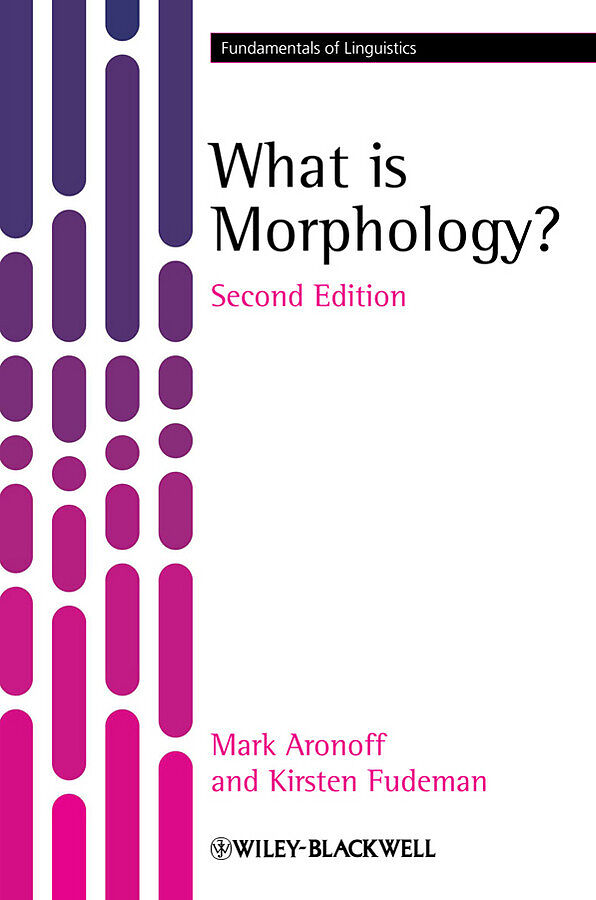What is Morphology?
Format:
E-Book (EPUB)
EAN:
9781444351767
Untertitel:
Englisch
Genre:
Sprach- und Literaturwissenschaft
Autor:
Mark Aronoff, Kirsten Fudeman
Herausgeber:
Wiley-Blackwell
Auflage:
2. Aufl.
Anzahl Seiten:
312
Erscheinungsdatum:
11.07.2011
ISBN:
978-1-4443-5176-7
What is Morphology? is a concise and critical introduction to the central ideas of morphology, which has been revised and expanded to include additional material on morphological productivity and the mental lexicon, experimental and computational methods, and new teaching material. * Introduces the fundamental aspects of morphology to students with minimal background in linguistics * Includes additional material on morphological productivity and the mental lexicon, and experimental and computational methods * Features new and revised exercises as well as suggestions for further reading at the end of each chapter * Equips students with the skills to analyze a wide breadth of classic morphological issues through engaging examples * Uses cross-linguistic data throughout to illustrate concepts, specifically referencing Kujamaat Joola, a Senegalese language * Includes a new answer key, available for instructors online at href="http://www.wiley.com/go/aronoff">http://www.wiley.com/go/aronoff
Autorentext
Mark Aronoff is Professor of Linguistics at Stony Brook University (SUNY). He is co-editor, with Janie Rees-Miller, of The Handbook of Linguistics (Wiley-Blackwell, 2001), and served as editor of the journal Language from 1995 to 2000.
Kirsten Fudeman is Professor of French at the University of Pittsburgh. She is the author of Vernacular Voices: Language and Identity in Medieval French Jewish Communities (2010).
Klappentext
Assuming only the most basic background in linguistics, What is Morphology? provides a concise, critical introduction to the central ideas and perennial problems of morphology. Designed to familiarize beginning students and specialists alike with the importance of morphology as a subject of research, this reader-friendly volume moves organically from the morphological facts of everyday life to important relationships with phonology, syntax, and semantics.
This second edition builds on the previous one, expanding chapters on morphological productivity and the mental lexicon, and adding coverage of experimental and computational methods. Aronoff and Fudeman have revised and expanded the exercises and added suggestions for further reading to each chapter. Data from Kujamaat Joola, a West African language, is used throughout the book to explain and clarify new ideas presented. What is Morphology? equips readers with the skills to analyze a wealth of classic morphological issues through engaging narration and by direct example.
Zusammenfassung
What is Morphology? is a concise and critical introduction to the central ideas of morphology, which has been revised and expanded to include additional material on morphological productivity and the mental lexicon, experimental and computational methods, and new teaching material. Introduces the fundamental aspects of morphology to students with minimal background in linguistics Includes additional material on morphological productivity and the mental lexicon, and experimental and computational methods Features new and revised exercises as well as suggestions for further reading at the end of each chapter Equips students with the skills to analyze a wide breadth of classic morphological issues through engaging examples Uses cross-linguistic data throughout to illustrate concepts, specifically referencing Kujamaat Joola, a Senegalese language Includes a new answer key, available for instructors online at http://www.wiley.com/go/aronoff
Inhalt
Preface viii Acknowledgments xiv Abbreviations xv Remarks on Transcription xviii The International Phonetic Alphabet xx 1 Thinking about Morphology and Morphological Analysis 1 1.1 What is Morphology? 1 1.2 Morphemes 2 1.3 Morphology in Action 4 1.4 Background and Beliefs 10 1.5 Introduction to Morphological Analysis 12 1.6 Summary 22 Introduction to Kujamaat Jóola 23 Further Reading 26 Exercises 27 2 Words and Lexemes 33 2.1 What is a Word? 34 2.2 Empirical Tests for Wordhood 38 2.3 Types of Words 40 2.4 Inflection vs. Derivation 47 2.5 Two Approaches to Morphology: Item-and-Arrangement, Item-and-Process 49 2.6 The Lexicon 54 2.7 Summary 57 Kujamaat Jóola Noun Classes 58 Further Reading 67 Exercises 68 3 Morphology and Phonology 73 3.1 Allomorphs 74 3.2 Prosodic Morphology 78 3.3 Primary and Secondary Affixes 82 3.4 Linguistic Exaptation, Leveling, and Analogy 86 3.5 Morphophonology and Secret Languages 93 3.6 Summary 95 Kujamaat Jóola Morphophonology 96 Further Reading 103 Exercises 104 4 Derivation and the Lexicon 109 4.1 The Saussurean Sign 109 4.2 Motivation and Compositionality 110 4.3 Derivation and Structure 123 4.4 Summary 130 Derivation in Kujamaat Jóola 131 Further Reading 132 Exercises 133 5 Derivation and Semantics 136 5.1 The Polysemy Problem 137 5.2 The Semantics of Derived Lexemes 139 5.3 Summary 147 Derivation and Verbs in Kujamaat Jóola 148 Further Reading 151 Exercises 152 6 Inflection 157 6.1 What is Inflection? 159 6.2 Inflection vs. Derivation 168 6.3 Inventory of Inflectional Morphology Types 171 6.4 Syncretism 177 6.5 Typology 178 6.6 Summary 180 Agreement in Kujamaat Jóola 182 Further Reading 187 Exercises 189 7 Morphology and Syntax 196 7.1 Morphological vs. Syntactic Inflection 197 7.2 Structural Constraints on Morphological Inflection 198 7.3 Inflection and Universal Grammar 201 7.4 Grammatical Function Change 203 7.5 Summary 209 Kujamaat Jóola Verb Morphology 212 A Brief Survey of Kujamaat Jóola Syntax 219 Further Reading 222 Exercises 223 8 Morphological Productivity and the Mental Lexicon 226 8.1 What is Morphological Productivity? 227 8.2 Productivity and Structure: Negative Prefixes in English 230 8.3 Degrees of Productivity 231 8.4 Salience and Productivity 236 8.5 Testing Productivity 238 8.6 The Mental Lexicon, Psycholinguistics, and Neurolinguistics 246 8.7 Conclusion 252 Further Reading 253 Exercises 254 Glossary 258 References 273 Index 280

Leider konnten wir für diesen Artikel keine Preise ermitteln ...
billigbuch.ch sucht jetzt für Sie die besten Angebote ...
Die aktuellen Verkaufspreise von 3 Onlineshops werden in Realtime abgefragt.
Sie können das gewünschte Produkt anschliessend direkt beim Anbieter Ihrer Wahl bestellen.
Loading...
Die aktuellen Verkaufspreise von 3 Onlineshops werden in Realtime abgefragt.
Sie können das gewünschte Produkt anschliessend direkt beim Anbieter Ihrer Wahl bestellen.
| # | Onlineshop | Preis CHF | Versand CHF | Total CHF | ||
|---|---|---|---|---|---|---|
| 1 | Seller | 0.00 | 0.00 | 0.00 |
